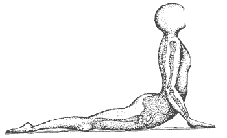This article continues on from The Secret of Asanas
Practicing Hatha Yoga
By contrast with the normal approach in sports, asanas do not intend to increase the muscular mass, the force, speed or endurance – they don’t aim for effort. In fact, asanas are the exact opposite of aerobics and other sports. The keyword here is “suppleness”. The practice of asanas should not be accompanied by effort.
The asanas are conceived in such a way that the muscles are not involved in their execution. Instead of compressing the muscles, an asana elongates them. The joints and the muscles are stretched and this does not require effort. In fact it is normal that after a couple of hours of Hatha Yoga a practician should feel more energetic and vibrant than in the beginning of the session, as opposite to a sports practician who usually feels tired and worn-out.
Here is a list of simple rules that are of great help when practicing asanas :
- choose a certain time of day and practice asanas at the same time every day
- the place for practice should be private and away from agitation; you need a quiet retreated place that will give you privacy for the duration of your exercises
- it is recommended that you practice on a blanket that can cushion you from the cold or hard floor
- before starting the sequence of asanas, you need to do the warm-up exercises; do not avoid them because otherwise you may harm yourself while stretching in asanas
- while performing an asana do not let your mind wander around; instead, focus on the specific chakras that are associated to that particular pose. Remember that asana practice is a form of meditation. If you do not focus on the right chakras, the spiritual efficiency will drop under 5%.
- after the execution of each asana you want to take a minute to fully assimilate into your consciousness the specific effects; this consciousness-awareness phase can be executed in a comfortable position and is a key to success in Hatha Yoga
- do not force your way through asanas; the asana should be stable and comfortable
- before starting to practice any asana you should read the counter-indications and avoid any health hazards; many asanas have specific counter-indications and you shoud never ignore them
- it is much better to do 20 minutes of Hatha Yoga every day than a one-time two hours session every week; do not overdo it in the beginning because you do not want to last only a couple of weeks, you want to keep the practice up for many years
- by maintaining the same time and location you establish a beneficial resonance that will help you a great deal in the long run; when the time for yoga comes you will feel “magically” attracted to start practicing
- asanas executed in group are much more efficient than asanas performed alone; the more people executing the same asana at once, the better; responsible for this increased effect is the same “law of resonance”, only in this case 1 plus 1 gives more than 2
- do not forget to perform the relaxation pose after each asana session
In our website you will find the most complete descriptions of asanas ever published on the net. For the first time in the world, the correlations of asanas with chakras are revealed. We wish you success with the practice and let us know about your results!
Horia Cristescu of Sivasakti.com
Further Articles of interest :
























Speak Your Mind